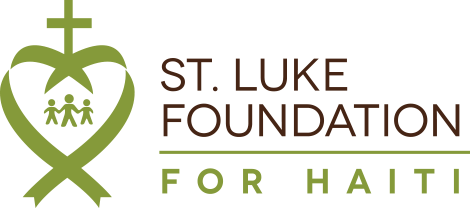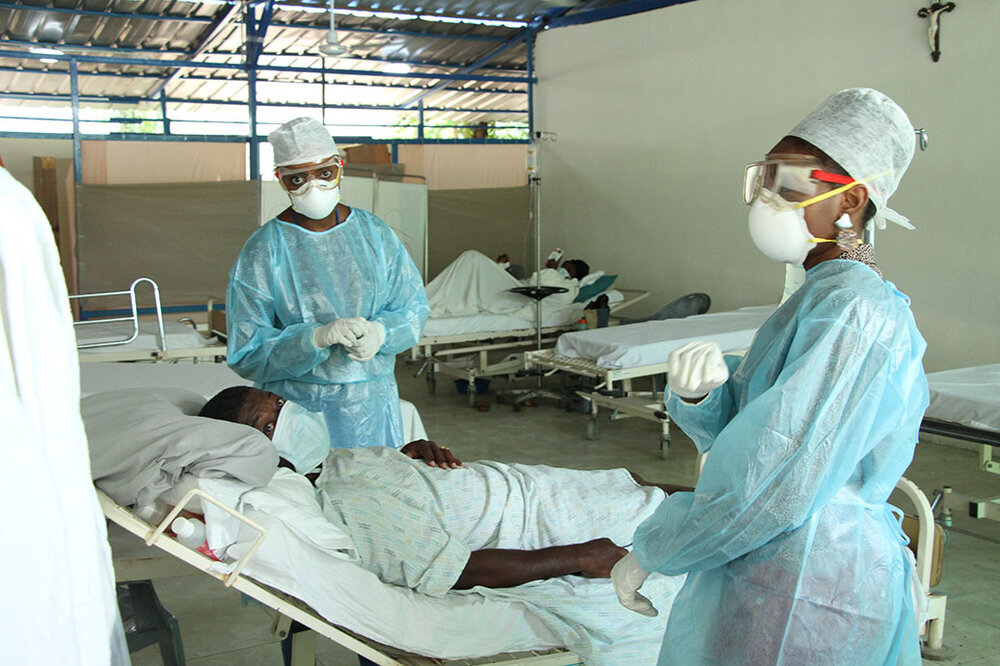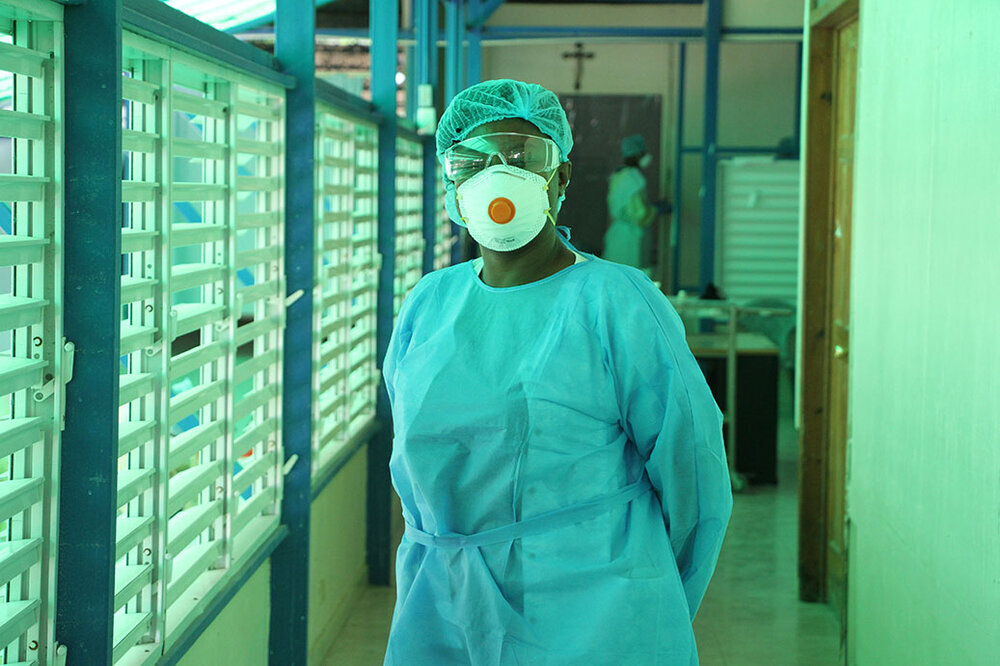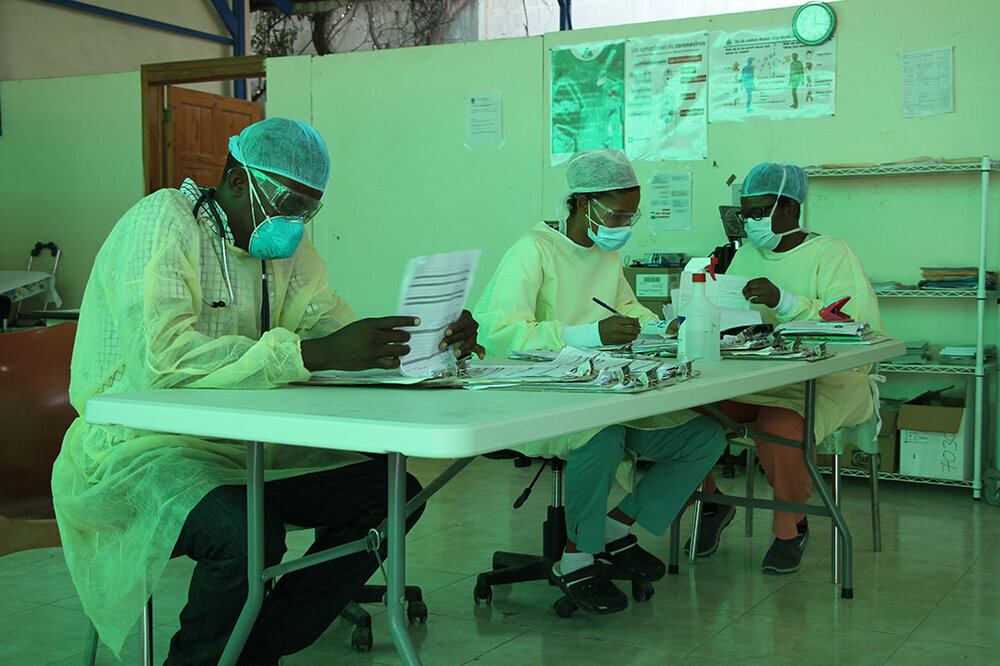Lessons from Covid19- From Fr. Rick
/As our good friend Bhavesh (at Mayo Clinic, Phoenix) has correctly said, when it comes to COVID 19, we physicians are all medical students again.
We have had to confront the illness with a challenging learning curve. We constantly learn from the experience of colleagues in Europe and the USA, and from our own experiences.
And all of us are learning new things daily, and having to modify what we thought we just learned.
We started facing COVID patients in Haiti protected by masks made of donated bath robes, and $1 plastic welders glasses.
Worldwide stocks of normal medical protective gear was at a critically low levels because the European and American cases of COVID 19 were skyrocketing.
Since then, thankfully, many people have come forward to help us find the correct protective gear that we need to stay safe, as we care directly for people infected by the virus.
At the beginning stages, we learned that COVID would be like a bad flu, affect only the lungs, and mortality might be 2%.
Now, having set up units for respiratory illness both at St Damien and St Luke hospitals, we understand that the focus on the lungs, and organizing everything around respiratory illness, is a very narrow and dangerous focus.
Because many systems of the human body can be damaged by the COVID.
Another physician colleague reminded us of the saying, in regards to syphilis (which causes great damage to many body systems, and imitates a wide variety of illnesses) "if you know syphilis inside and out, you know medicine."
Now the same seems true of the COVID 19.
We initially separated St Luc and St Damien hospitals into "THIS WAY FOR CORONA OR SUSPICION OF IT, AND THAT WAY FOR EVERYONE ELSE.
This dual pathway was totally challenged by colleagues at Stony Brook University Hospital (Long Island), who warn that dual thinking invites infection, by lowering one's guard.
In fact, after two proven positive COVID 19 cases in St Luke Hospital (the main hospital, not the covid wing), we now also have two infected physicians (and other medical staff in quarantine), and we have wisely adopted the SINGLE PATHWAY of prevention.
Another main focus at the beginning of COVID was to be sure there were enough mechanical ventilators to handle all the infectious cases.
In Haiti it would be hard for us to find even 6.
Slowly, however, the statistics have shown very poor survival rates of people needing mechanical ventilation for COVID.
The new focus was how to avoid mechanical ventilation, by studying the so called "cytokine storm", a very strong reaction of the person's immune system to the virus, in which the body harms itself.
Discussions included suggestions to induce immunosuppression in the patients in order to avoid this storm (a counterintuitive idea, since your body needs to fight the invading coronavirus virus via your immune system. It's what your immune system is for!)
The thinking represented a hope if you could get someone past the danger of cytokine storm, they could have a fighting chance to get well again.
Then there was the discovery of the "happy hypoxics", whose blood oxygen levels were so low they should have been given immediate and intense oxygen therapy, but their body doesn't recognize that it is so deficient in oxygen- and they don't feel sick. That's like not hearing the tick of a bomb about to go off right next to you.
A disconnect is caused by the virus between reptilian-level breathing center in human the brain stem, and brain's alert to the heart and lungs to increase their work.
The important adjustment in patient care here is to recognize the "happy hypoxics" before they become lifeless hypoxics, by using a finger pulse oximeter and identifying EARLY when oxygen levels are below 95 % (and especially below 90%), and treat early with oxygen.
Another early hope: that a cocktail of azithromycin, chloroquine and zinc (I still prefer a gin & tonic), would help to reduce the severity of illness.
We were also offering this cocktail, until harmful effects started getting reported in many places. There may still be benefit if it is given early in the infection.
But we have no way in Haiti to know when early is, for many reasons I list further down.
Since March 16, the date of the official appearance of COVID 19 in Haiti, we have received just over 200 suspicious cases.
Our testing ability has been very limited and is slightly improving, and getting the results has been with disastrous delays, and is also slightly improving.
The people who have come to us range in age from 17 to 92.
They have come mostly from poverty and some from the middle class.
Many are also sick with other illnesses like TB, HIV, diabetes, asthma, hypertension, heart failure, anemia, sickle cell disease, malnutrition, and many other problems.
While the benefits of population testing are limited unless there is widespread testing (testing in Haiti is not widespread), still the only "real" information allowed to be reported are the confirmed positives.
Of our 200 suspicious patients, about 115 were able to go home with simple treatments, and instruction on responsible isolation.
85 people needed to be hospitalized, and of these, about 13 died.
Of these 85, about 20 were officially COVID, by testing.
Of the 13 deaths, 3 were officially COVID, by testing.
Here are some facts about our setting in Haiti.
Many people do not believe the disease is real, but a fabrication of the government for money in the form of international aid.
Many people do not trust the government, the ministry of health, the media, and do not want to come to centers and be controlled by them.
Many people mix spiritual causes with physical causes of illness, and want to leave the hospital for traditional spiritual cures.
For many people the COVID illness brings shame and fear. The fear is especially of being attacked or killed by people who blame them for spreading the disease.
A majority people who come to us have massive economic and social problems: no where to live, nothing to eat, no work.
These factors lead to a lot of aggression, and disturbed thinking and behavior, that is often directed at us, the caregivers.
When the COVID 19 first came, we scrambled to renovate the old cholera wing of St Luc hospital.
We raise the roof to increase air flow and reduce heat, and renovated the toilettes and showers.
This gave us 40 beds for COVID or suspected cases.
When more funds came in, we renovated the electricity of the same are (lights and fans), and could buy chairs and add a television for distraction.
As the cases increased and more funds came in, we created a new area for families who stay on the grounds to help with the care of their sick.
This required construction of simple shelters, renovating a kitchen, running water and power lines.
Once the family area was moved, we were able to renovate the area where the families had been, especially toilettes and showers, thereby adding an additional 40 beds.
We have also turned the outpatient clinic into a COVID area, with 10 additional beds.
So we now have 90 COVID beds, and are ready to add additional beds at sites to be determined (Villa Francesca guest house, Francisville Warehouse, APJ academy, etc)
according to the need - since the deadly spike of the virus is predicted for this month of May.
This we will do as more funds are available, and in addition, as we can, we will put false ceilings in all the above areas to reduce the heat.
Slowly we add: water coolers, mosquito nets, bed curtains for privacy, etc.
We are organized for the best possible human care in this way:
1.A separate area for the more or less healthy COVID positives, in the outpatient clinic. They are isolated, have a garden to walk and sit in, can speak to their families at a 15 foot outdoor distance, everyone masked.
2.A separate area for the sick COVID positives who need a special and often intensive eye on them. They are bedridden and air conditioned.
3.A separate area for more or less healthy suspicious cases (some with exposures, some symptomatic.) There are separate areas for men and women. All can speak to their families at a 15 foot outdoor distance, everyone masked.
4.A separate area for the sick suspicious for COVID, who need a special and often intensive eye on them.
For all the above categories of people, we converse in friendship, try to understand and help with their other problems, and we have prayers together.
This is how things stand with us, two months into this pandemic in Haiti.
We are doing our best, within our circumstances and our means. Yet our best is painfully far from perfect,
On a final note, we will soon release a sung prayer from our young people, high school age.
The small choir is made of St Luc and NPFS students combined.
It is a prayer for Haiti and for the world, as we live through this time of pandemic.
An ancient invocation to the Holy Spirit (1,100 years old) is combined with a contemporary Creole hymn to the Holy Spirit.
We will post it on our site, and release it on Catholic Haitian Radio, and also on social media in the coming week.
We so appreciate your help, and we pray for you in song.
Fr Rick Frechette CP
May 9, 2020





